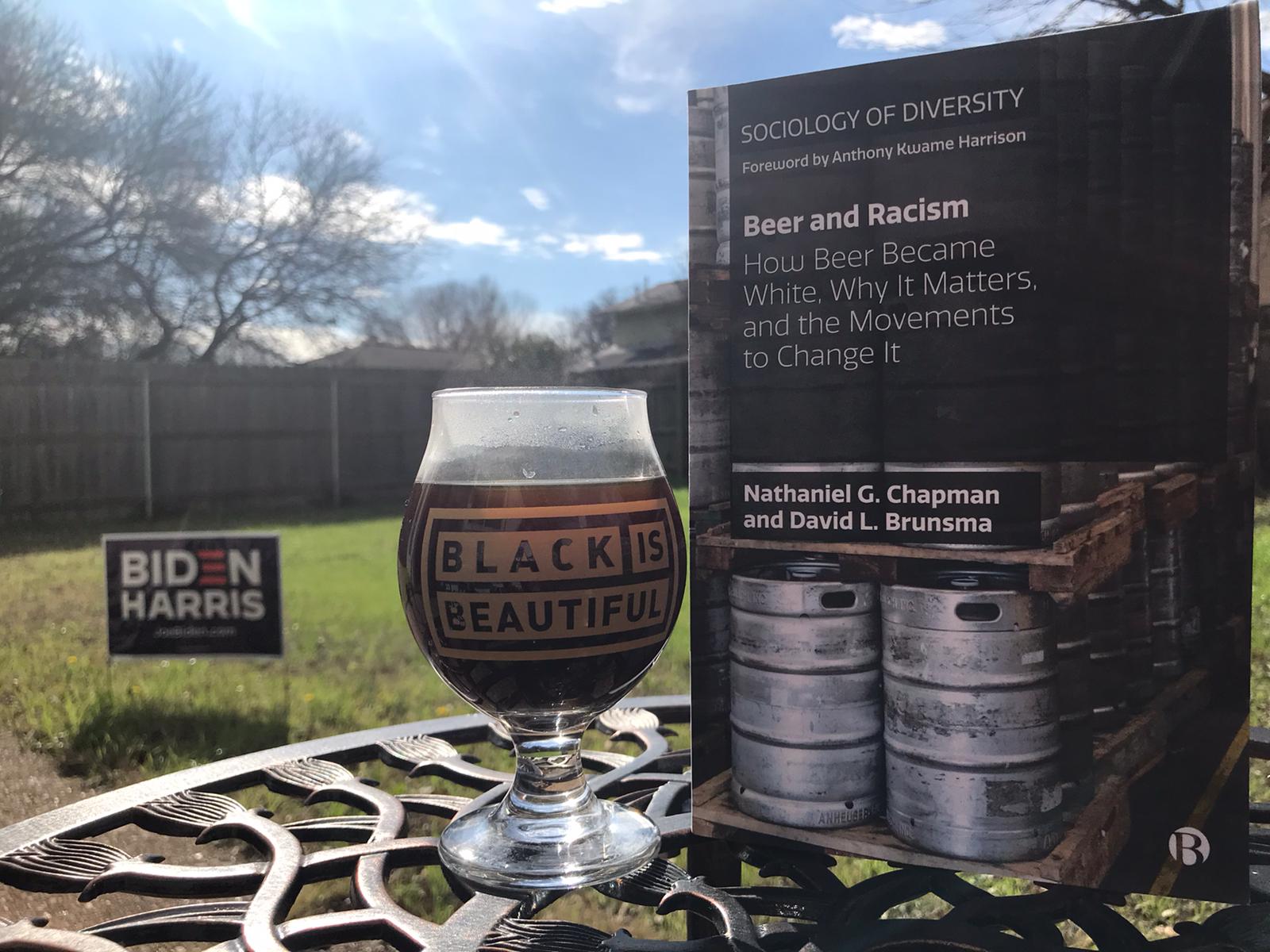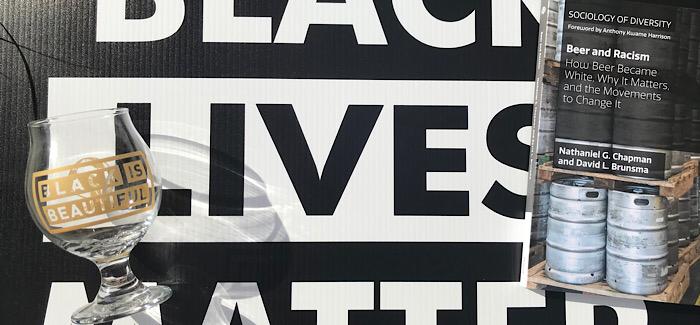Book Review | Beer and Racism
Most people of color living in majority-white countries regularly encounter racism, be it violent, cruel and open prejudice or nasty little microaggressions. Sadly, this is a fact. But what do you do when your job, your hobby or both are imbued with structural racism? When it stops being about individual attitudes and becomes about organizational and institutional frameworks and hierarchies that, in their very nature, are skewed to exclude people of color?
Beer and Racism is the first academic book to tackle the subject of racism in beer, and I cannot overstate its importance in offering a factual explanation for and positive solutions to correct the huge issue of racism in the American beer industry. Researched and written by sociologists Nathanial G. Chapman and David L. Brunsma, the book offers an excellent historical, sociological and evidence-based analysis of why the beer industry is racist, how it came to be that way and what can be done about it. This is a well-researched, informative, empathetic and, crucially, extremely readable piece of work on what is undeniably an incredibly important issue.

You may not be aware of how difficult it can be to enter the industry if you are not part of the favored demographic of white males. You also may not know how the established structures of the American beer industry act as barriers, preventing it from becoming more accessible. How much you know may not be anything close to an accurate reflection of how much you care. And this is why this piece of academic scholarship is so important — it provides a positively clinical analysis of exactly how and why the beer industry is racist and what can be done to affect real, meaningful change.
Whether we like it or not, beer is a cultural object; and cultural objects are, by their very nature, high status. Cultural production denotes leisure, money and power. Beer, like most other creative industries, has been subject to colonization by a white-dominated society keen to stamp their ownership on the means of cultural production. If you control music, art, literature; if you have the power to define good taste, control who has access to it and who gets to produce it, you are tacitly exerting social control. The same is true for beer. Every time a person of color hits that wall denying them access, telling them “this isn’t for you,” they’re being put in their place as not good enough, not white enough to deserve access to the means of cultural production. They’re in effect being told that taste-making is a job for white people.
The authors identify the ways in which the logistics of the beer industry chime with pre-existing cultural prejudices, stereotypes and assumptions to form what, in effect, is a racist barrier to keep people of color, and, specifically, Black people out of beer. You don’t need to be an academic or have an academic background to understand and appreciate the arguments that the authors make. Anyone who has observed the way in which beer and other cultural industries are organized will immediately recognize the issues the authors are describing. When less-qualified white colleagues get promoted above you, when you’re rejected for a role because you “don’t have the right look,” when you struggle just to get an interview but your white friend gets hired on sight, you know that the system is broken and there’s nothing you can do about it.
This book breaks down the means and structures by which the beer industry is de facto racist using clean, precise methodology. The authors begin with the historical context of white-washed mythmaking that reverberates through all American cultural signifiers. They then examine the racialized impact of the post-Prohibition three-tier distribution system and how this has led to the essential qualification of “who you know” as a gateway into the industry. Chapman and Brunsma pick apart the many givens of industry access, highlighting how these historic and cultural norms have acted as barriers to diversity in beer. They continue the story by unpicking the role of marketing and distribution in keeping beer white, using the example of malt liquor and the racist way it has been marketed to the Black community, only to then become an agent of cultural appropriation when white college kids began to drink it in order to emulate Black hip-hop icons. This strategy of segmented, targeted marketing based on racialized, racist demographic profiling is hugely problematic. By labeling malt liquor as “Black” and beer as “white,” marketers created a falsely segmented drinking culture based on stereotypes and prejudice. This has had a significant impact on the modern perception of beer in communities of color. Chapman and Brunsma offer a vital analysis of the difficulty of breaking down and upending a manufactured reality that has become a self-fulfilling prophecy.
The authors proceed with a detailed analysis of the role of gentrification in the craft beer world, and how craft beer’s status as an emblem of gentrification alienates it from people of color who are systematically removed from their neighborhoods to make room for white physical and cultural spaces. Chapman and Brunsma detail the cultural and sociological impact of displacement through gentrification, and, crucially, the way this is reflected in the demographics of craft beer taprooms. Put simply, people of color are unlikely to enter a space in which they are not represented, and in which they do not feel safe and welcome. This is why opening up access to the industry, hiring people of color and pursuing quantifiable and specific diversity goals, including active community outreach are absolutely essential in breaking down the racist structures underpinning the beer industry.
If that all sounds like a bit of a mouthful, it really isn’t. While Chapman and Brunsma do use a lot of academic language and analysis, the text is consistently contextualized with real examples, often using their freshly gleaned data taken from surveying 15 respondents from the beer industry over a total of 907 minutes. These anecdotes offer essential insight into how these academic theories translate on the ground, providing real-life back-up to each step of the authors’ analysis. When Black male influencer Tony recounts, “There weren’t any apprenticeships like the ones that White folks are privy to… So, the aspiration to be part of the industry was viewed by us as more of a product of privilege,” he speaks for every person of colour who hasn’t been afforded the connections, the encouragement or the time and money to make it into the industry. These are common, recognizable stories that can apply to all creative industries, detailing the infuriatingly close-knit networking web by which most hires are made. If you’re part of the “in-crowd,” you have a much better chance at that coveted, prestigious taste-maker role that outsiders quite simply don’t stand a chance at getting.
My own experience of othering and who you know in both the beer and publishing industries was certainly accurately reflected. It was incredibly reassuring to see my own experience both documented and, vitally, explained in a piece of academic scholarship. I have found it immensely difficult when these experiences are denied, which they often are, by white people who tell you that it must be you, that you’re just not good enough, that there are no racist forces at play and that you’re on an even playing field even when you know 100% that you are not. It’s both a relief and a source of great sadness to see academic evidence that I have not been alone in going through this.
This book is absolutely crucial in establishing, once and for all, that people of color are up against a system that is prejudiced against them, and that that system needs to change. This could not be more timely in the wake of #BlackLivesMatter. This is an essential read for anyone involved in beer or other cultural industries, and could not have arrived at a more prescient time. The feelings that we, as people of color, have about beer, about the struggle to get a toehold into the industry, about having to push harder to be heard, work harder to be taken seriously, never seeing ourselves represented in physical spaces or marketing images, not being part of the “in the club’ — these are all based on realities, realities which this book documents for everyone to read. So read it, and equip yourself with the tools to be part of the solution.
Beer and Racism by Nathaniel G. Chapman and David L. Brunsma is published by Bristol University Press, 2020.








Submit a Comment